Space shuttle Endeavour's rockets roll into L.A. as Science Center hails arrival
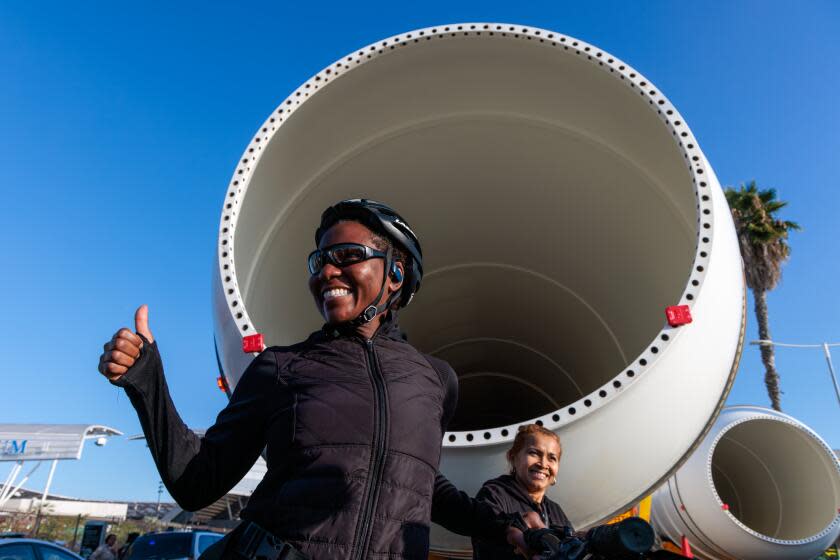
With a festive celebration worthy of the stars, Los Angeles welcomed the arrival of massive twin rockets Wednesday, the final pieces of large equipment before the space shuttle begins to be fully assembled in a grand museum exhibit next year.
The solid rocket motors — each weighing 104,000 pounds and the size of a Boeing 757 fuselage — came aboard two semi-trucks from the Mojave Air and Space Port, taking nine hours over two days and traversing seven Southern California freeways to arrive at the California Science Center in South L.A. The motors take up most of the length of the white solid rocket boosters, which are set beneath the space shuttle's wings and produced more than 80% of lift during takeoff.
The equipment will be a key component to the permanent exhibition of Endeavour, the last space shuttle built. After more than a decade in a horizontal position inside the museum, it will be configured into a full-stack arrangement as if it were being prepared for launch at the new $400-million Samuel Oschin Air and Space Center.
"I'm so excited to see this is happening," said Lynda Oschin, wife of the late Los Angeles businessman and philanthropist Samuel Oschin, an avid space enthusiast and namesake of the new museum. "The shuttle is everything that he loved all rolled into one."
Read more: Space shuttle Endeavour makes one more voyage to its final destination at a new space center
The solid rocket motors left Mojave on Tuesday morning and spent three hours traveling through the desert and the Cajon Pass before resting for about 15 hours in the San Gabriel Valley. The journey resumed around 3 a.m. Wednesday, and before their arrival around 9 a.m., the motors crept along Figueroa Street in South L.A. after exiting the 110 Freeway.
There, schoolchildren and adults alike gathered to cheer on the spectacle.
Some special guests were also on hand, including former astronaut Douglas G. Hurley, 57. He piloted the final space shuttle mission in 2011, aboard Atlantis, as well as a flight of Endeavour in 2009. He later served as spacecraft commander on the first crewed flight of the SpaceX Crew Dragon in 2020 and stayed aboard the International Space Station for 62 days. Hurley is now senior director of Northrop Grumman Space Systems, based in Utah, where he works on solid rocket boosters.
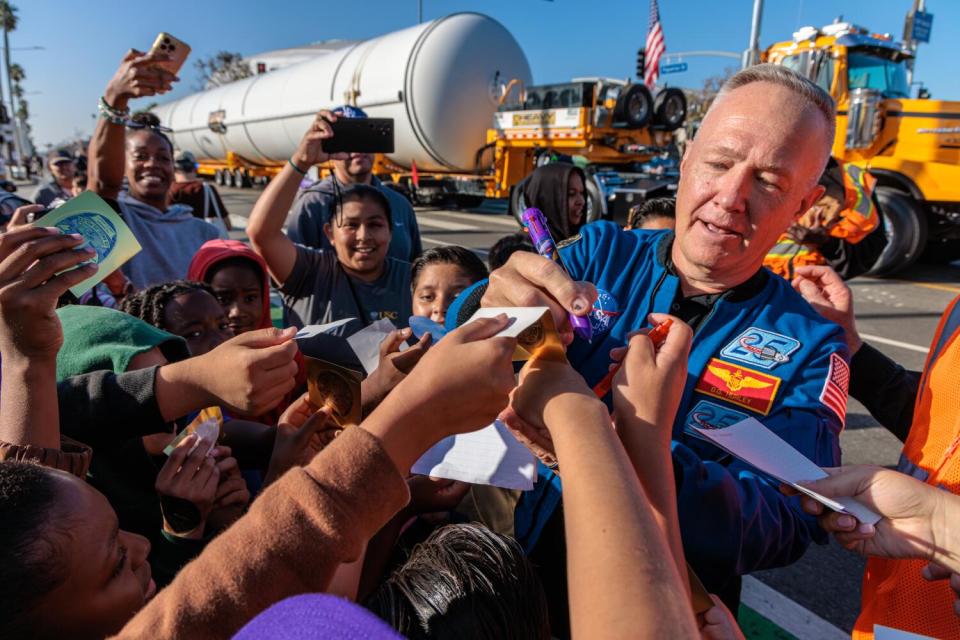
Spectators came on foot and by bicycle, eagerly taking photos on cellphones and posing in front of the impressively large rocket motors.
California Science Center President Jeffrey Rudolph marveled at how the space shuttle has become an indelible part of the fabric of Los Angeles since its arrival at the museum in 2012. Back then, Endeavour's flight aboard a modified Boeing 747 brought gasps to Californians as it soared over the Golden Gate Bridge and the Hollywood sign before landing at Los Angeles International Airport.
Read more: Space shuttle Endeavour preps for move to vertical landing in new museum
Rudolph said he spoke to one man who recalled bringing his date to watch Endeavour slowly roll through the city 11 years ago — a three-day, 12-mile journey from the airport to South L.A.
The couple has since married, and on Wednesday, they brought their children to see parts of the space shuttle system roll through the city again.
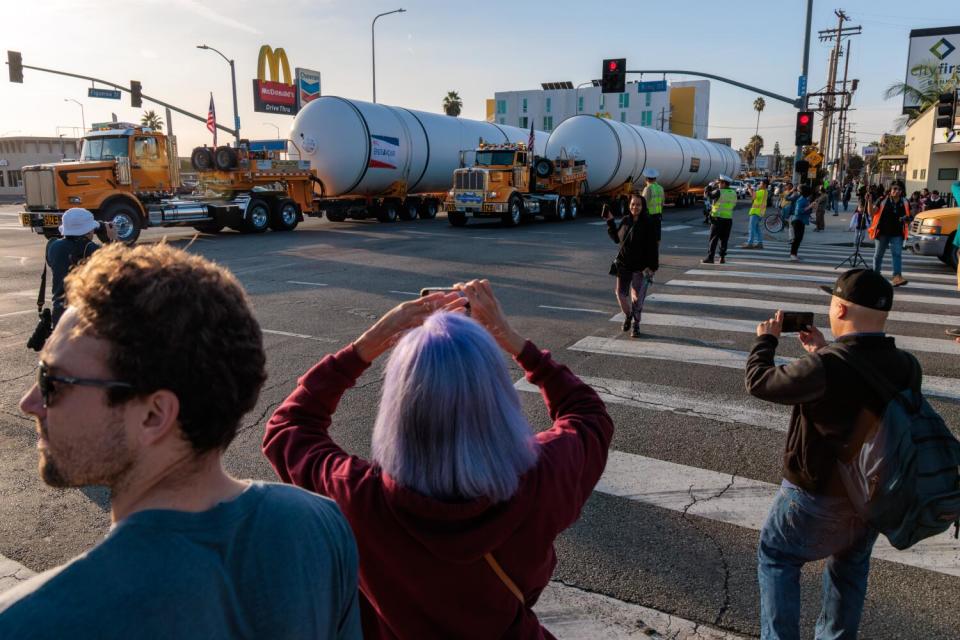
The solid rocket boosters that will be installed at the science center are authentic, and their parts have been used or reused in a number of space shuttle launches — from the fifth shuttle mission aboard Columbia in 1982 to the last flight of Discovery in 2011. The components of the two solid rocket motors flew on a combined 81 space shuttle flights and 32 static tests.
The reusable boosters produced more than 6 million pounds of thrust during liftoff, igniting only after the space shuttle's main engines were at full thrust, according to the science center. At launch, each motor had about 1.1 million pounds of polybutadiene acrylonitrile copolymer propellant, which has the consistency of a pencil eraser.
Read more: Shuttle Endeavour makes dramatic tour of California
The solid rocket boosters were donated to the California Science Center by Northrop Grumman, which builds the equipment in Utah. During the space shuttle era, they were shipped by train to Kennedy Space Center in Florida and delivered back to Utah to be prepped for future flights.
Notably, a modified version of the same solid rocket boosters were used on the first Artemis mission, NASA's new moon rocket, which underwent a test flight last year. According to NASA, the main difference between the space shuttle's rocket boosters and those of the moon rocket was the addition of a fifth propellant to the four-segment shuttle booster, allowing the latest launcher to lift more weight.
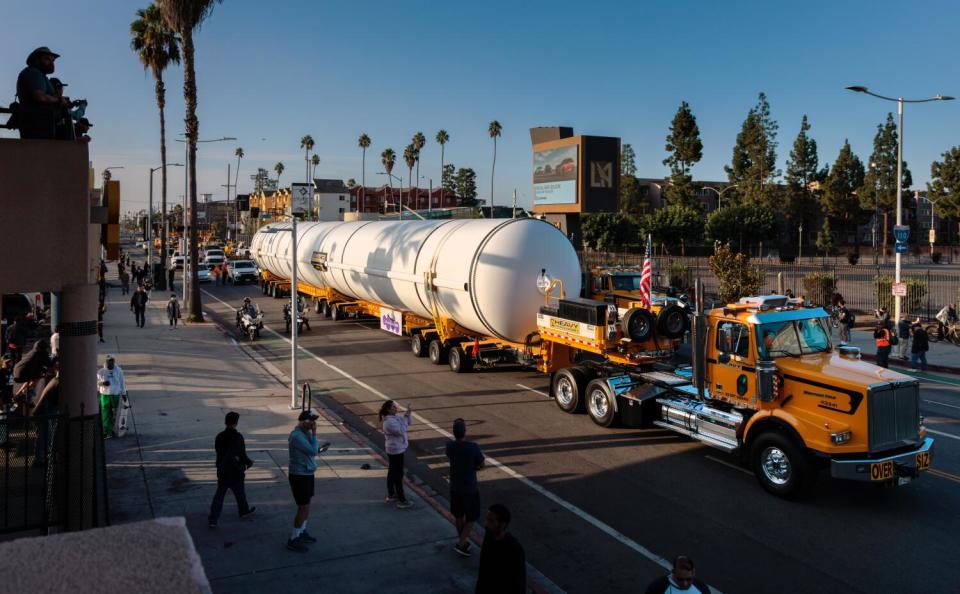
For the next few weeks, this will be the only time that all of the shuttle's major components — the Endeavour orbiter, the solid rocket boosters and the giant orange external tank — will be viewable at the science center without them being assembled together. The solid rocket motors will be stationed next to the museum's dining terrace during this span.
In early November, the California Science Center plans to use a crane to lift the rocket motors into place, installing them atop the base of the solid rocket boosters, which are known as the aft skirts. Crews will likely install one rocket motor per day, a process that can be tricky given that more than 100 bolts are needed to affix the rocket motors to the aft skirts.
Read more: Space shuttle Endeavour is getting its own grand museum in L.A., displayed in launch position
Later, the tip of the solid rocket boosters — the forward assembly, including the nose cone and forward skirt — will be installed atop the solid rocket motors. Before that installation, however, crews will need to set up scaffolding so the bolts can be properly affixed.
That will set the stage for the installation of the orange external tank, which will occur no earlier than early January, followed by the installation of Endeavour, no earlier than the last week of January. Cranes, the tallest of which will be about the height of City Hall, will raise Endeavour from its its horizontal position to point vertically to the stars for its final display. The rest of the museum will then be built around it.
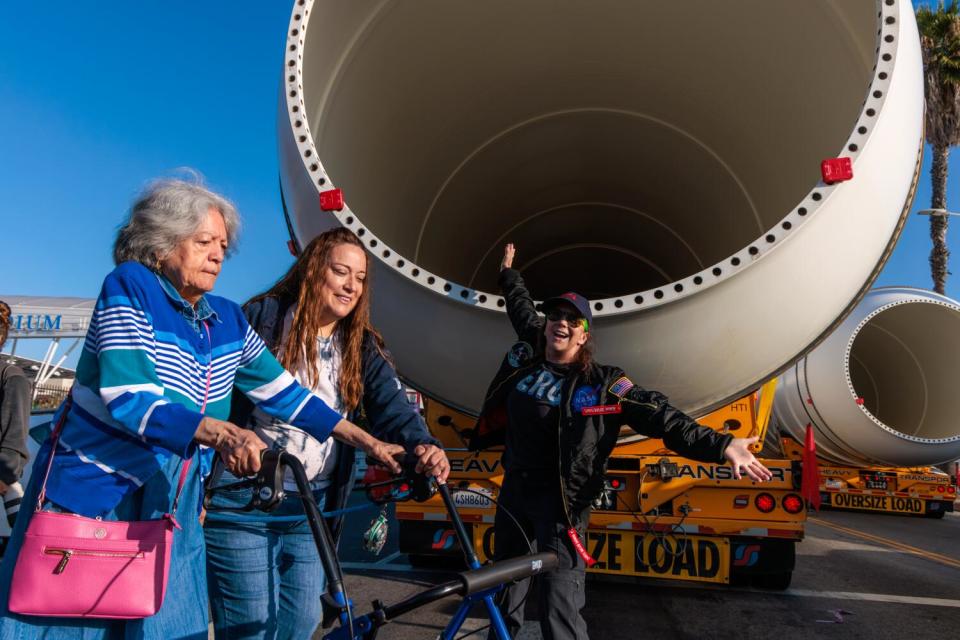
Since Endeavour’s arrival in 2012, the Endeavour has been on display in the temporary Samuel Oschin Pavilion, where it will be shown until Dec. 31. After that date, it could be years before Endeavour will again be available for up-close viewing by museum guests.
In mid-2022, the California Science Center broke ground on the new permanent museum, and three months ago, construction crews began installing the base of the shuttle’s full stack.
This story originally appeared in Los Angeles Times.

